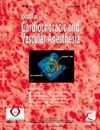介绍了一种独立于供应商的应用程序,用于从常规血流动力学数据生成压力-容量循环的临床应用:方法学探索。
IF 2.3
4区 医学
Q2 ANESTHESIOLOGY
Journal of cardiothoracic and vascular anesthesia
Pub Date : 2025-02-01
DOI:10.1053/j.jvca.2024.11.024
引用次数: 0
摘要
目的:在动态围手术期,液体状态的变化使心室功能的测定复杂化。本研究通过常规监测(超声心动图和有创压力监测)评估临床心室压力-容积环(PVL)构建的可行性。应用程序开发和测试双心室模拟数据和右心室(RV)临床数据。设计:前瞻性观察研究。环境:单中心,大学教学医院。参与者:需要心脏手术的成年人。干预措施:代码开发后,使用模拟数据集(harvey模拟器)来测试应用程序。接下来,研究人员分析了12名自愿接受选择性心脏手术的成人患者在4种不同生理环境下的RV数据,比较了仰卧基线状态与被动抬腿状态、维持高呼气末正压(PEEP)期间和胸壁打开后的情况。测量和主要结果:PVL综合3项收购的总体可行性为97.6%。得到的PVL参数符合预期模式:抬腿时,舒张末期容积(+36±23%;P = 0.0054)、脑行程量(+32±27%);p = 0.017)与稳定心率(HR)增强,导致心输出量增加(+34±33%);P = 0.06)。PEEP显著增加动脉弹性(+126±80%);P = 0.0000068)。开胸只造成轻微影响。结论:本研究引入了一个独立于供应商的应用程序,从常规可用的临床数据中生成pvl。结果突出了压力-体积框架在心血管研究和患者护理中的潜在应用。必须考虑到缺乏外部验证。需要进一步的研究来验证该应用。该应用程序可通过https://michael-vandenheuvel.shinyapps.io/eMv_Looper/访问。本文章由计算机程序翻译,如有差异,请以英文原文为准。
Introduction of a Vendor-Independent Application for Clinical Generation of Pressure-Volume Loops from Routine Hemodynamic Data: A Methodological Exploration
Objectives
In the dynamic perioperative setting, changing fluid states complicate determination of ventricular function. This study evaluated the feasibility of clinical ventricular pressure-volume loop (PVL) construction using routine monitoring (echocardiography and invasive pressure monitoring). An application was developed and tested with biventricular simulated data and right ventricular (RV) clinical data.
Design
Prospective observational study.
Setting
Single center, university teaching hospital.
Participants
Adults requiring cardiac surgery.
Interventions
After code development, a simulated dataset (Harvi simulator) was used to test the application. Next, RV data from 12 consenting adult elective cardiac surgery patients were analyzed in 4 distinct physiologic settings, comparing supine baseline condition with a passive leg raise setting, during maintained elevated positive end-expiratory pressure (PEEP), and after chest wall opening.
Measurements and Main Results
Overall PVL feasibility combining 3 acquisitions was 97.6%. Derived PVL parameters followed expected patterns: during leg raise, end-diastolic volume (+36 ± 23%; p = 0.0054) and stroke volume (+32 ± 27%; p = 0.017) augmented with stable heart rate (HR), resulting in a trend toward increased cardiac output (+34 ± 33%; p = 0.06). PEEP resulted in a marked increase in arterial elastance (+126 ± 80%; p = 0.0000068) compared to the other conditions. Chest opening resulted in minor effects.
Conclusions
This study introduces a vendor-independent application to generate PVLs from routinely available clinical data. The results highlight the potential application of the pressure-volume framework in cardiovascular research and patient care. A lack of external validation must be taken into account. Further research is warranted to validate the application. The app can be accessed at https://michael-vandenheuvel.shinyapps.io/eMv_Looper/.
求助全文
通过发布文献求助,成功后即可免费获取论文全文。
去求助
来源期刊
CiteScore
4.80
自引率
17.90%
发文量
606
审稿时长
37 days
期刊介绍:
The Journal of Cardiothoracic and Vascular Anesthesia is primarily aimed at anesthesiologists who deal with patients undergoing cardiac, thoracic or vascular surgical procedures. JCVA features a multidisciplinary approach, with contributions from cardiac, vascular and thoracic surgeons, cardiologists, and other related specialists. Emphasis is placed on rapid publication of clinically relevant material.

 求助内容:
求助内容: 应助结果提醒方式:
应助结果提醒方式:


